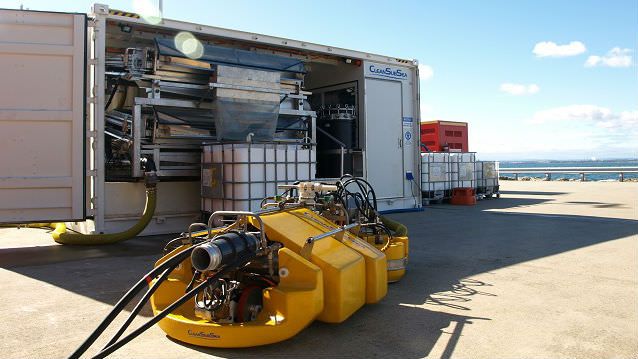The Envirocart - A Practical Biofouling Management Solution for International Vessels
Published on by Water Network Research, Official research team of The Water Network in Technology
The Australian company GRD- Franmarine conducted the first commercial demonstration of its hull cleaning technology at the Australian Marine Complex in Western Australia.
By MarEx
The Envirocart technology is the first system to receive government approval to conduct in-water hull cleaning in Fremantle and Pilbara Ports since the practice was banned in Australia and New Zealand in 1997.

Envirocart is a fully enclosed capture and containment hull cleaning technology that cleans the hulls of large vessels in the water. The system features a multi-stage filtration system that captures particles down to 15 microns in size, ensuring all bio-organic particles removed by the non-abrasive cleaning system are captured and contained in a way that meets the most stringent bio-security guidelines in the world.
Diver-steered, it features a surrounding skirt and three sets of blades that rotate 20mm above the surface of the hull. The high-speed rotation creates a powerful vortex that sucks the biofouling from the hull. Drive wheels propel the Envirocart forward as it cleans.
A forward-facing 45 degree angle ensures all debris is lifted clear of the hull without dragging and scratching the anti-fouling paint, enabling even soft anti-fouling coatings such as silicon to be cleaned without damage. This has been proven in Intersleek underwater cleaning panel tests conducted by International Paint, says GRD-Franmarine, and makes Envirocart different from other systems which rely on abrasion to remove fouling.
For irregular surfaces, shrouded hand tools and a containment box have been developed. Each cleaning tool has a suction shroud that connects separately to the central, fully enclosed suction system.
When the biofouling is extracted it flows into a large surface filtration system that can process up to 2,000 liters per minute. The biofouling is captured though a series of filters and contained. The filtered water is treated with UV before being discharged back into the ocean. The company is also exploring the potential for using the material in agriculture.
Read full article: The Maritime Executive
Attached link
http://www.youtube.com/embed/LAjQB9IU41MMedia
Taxonomy
- Treatment
- Microbiology
- Environment
- RO & MSF Fouling
- Oceanographic Survey
- Environment
- water treatment